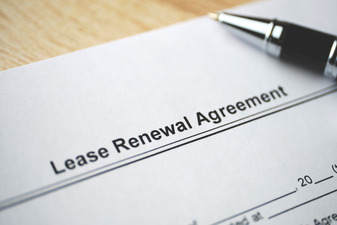A lease renewal is the process of establishing a new rental agreement with the current tenants. If the landlord or property manager is happy with the tenants and the tenants are happy with the home, it makes sense to re-up and keep the relationship going.
If you’ve dotted your i’s and crossed your t’s as a landlord or property manager, and you’ve checked out the advice in our guide for improving resident retention in rental properties, you very well may have a lease renewal on your hands. Congratulations! However, there’s more to it than just collecting rent for one more year, and there’s more than one way to renew (or extend) a lease agreement: you have options, and successful property management companies employ robust processes for lease renewal and extension, including firm protocols and standardized forms and addendums.
The Benefits of Lease Renewal

Retaining a resident is a huge win, because it translates to one less costly vacancy that you have to contend with. Tenant turnover is a killer, because when a tenant seeks out greener pastures instead of renewing or extending their lease agreement, the landlord or property management company has to shell out for a make-ready, offer tours to applicants, and screen prospective tenants—all things that cost money and time, plus the added strain of no incoming rent payments for the rental property for as long as the turnover process takes. So how do you ensure a smooth lease renewal process when a tenant does decide to continue renting your property? Read on to find out.
What If You Don’t Want to Renew a Tenant’s Lease?
Let’s say you’ve held up your end of the bargain, and as a result your tenant is happy: they want to renew their lease agreement. But what if, looking at their track record over the course of the tenancy, you see multiple late rent payments, noise complaints, and lease violations? Yes, a vacancy should be avoided at most costs, but if a tenant is costing you time and money, you may want to consider not renewing or extending their lease agreement.

However, if you go this route, don’t fire from the hip: before we dive into the ways you can standardize the lease renewal process, let’s touch on how to standardize the process of rejecting a lease renewal proposal. If you’ve determined that you don’t want to renew or extend a tenant’s lease, technically (depending on how your lease agreement is set up) you don’t need to notify them that they will need to vacate at the end of the rental term. However, the last thing you want is a confrontation with a tenant who didn’t pack a single box because they assumed their lease would just roll over. Just as important as a lease renewal letter or form (we’ll get to that shortly), is its opposite: it’s good to have a standardized letter on hand for any tenant whose lease you don’t want to renew or extend. The key is to keep it brief, clear, and informative. Here’s an example of the meat of such a letter:
We are unable to extend or renew your lease ending on [DATE], after which date we expect you to have vacated the property. Please contact us should you have any questions or concerns regarding this matter.
It’s advisable to seek expert legal advice when crafting such a letter to ensure that it unequivocally aligns with the stipulations regarding lease renewal set out in your rental agreement. And to get out ahead of any potential disagreements, send this letter well in advance of the expected move-out date.
Lease Renewal vs. Lease Extension
If your tenant wants to renew their lease, but they aren’t exactly sure they want to stay for an entire additional year, you have another option: consider extending their lease agreement instead. A lease renewal technically entails writing up and signing a whole new lease agreement, whereas a lease extension merely extends the terms of the existing lease for a set amount of time—a monthly basis, for example. Now of course this isn’t ideal, as it likely means that you will soon have to contend with a vacancy, but if the tenant is responsible and low-maintenance, you may as well keep them on however much longer they’d like to stay.
Renewing the Lease Agreement: Letters, Forms, Addendums and More
In the property management business, it’s best to get everything in writing, and as such the lease renewal process really begins the moment that a new tenant signs the initial lease agreement. The most efficient way to ensure a smooth and orderly lease renewal is to lay each of its steps out in clear terms within the rental agreement itself. Consider including an addendum within the rental agreement so that your tenants know what to expect when it comes time to extend or renew their leases. During the lease-signing process, it’s also a good idea to inform the tenant of their options regarding renewal vs. extension. Here is an example of an item you might include within your lease:
Tenant is required to give 30-day written notice of intent to vacate prior to the last month of expiration of the lease. If tenant fails to give such notice, a new one-year tenancy shall be created.
Of course, you might prefer the opposite: the lease simply terminates if the tenant doesn’t give notice of intent to renew or extend. The choice is yours.
Okay, that’s one school of thought when it comes to lease renewal—simply put it in the lease and let the car drive itself. Another is to include such items in the lease, but also to enter into a kind of conversation far in advance of the lease’s date of termination. This is probably the cleaner option, because it gives both you and your tenant plenty of time to hash out any misunderstandings or faulty assumptions, and to negotiate new terms, if need be. A rough skeleton for this approach might look something like this:
- 3 months before end of lease: Assess the tenant’s history in the rental, including things such as late rent payments or lease violations; determine whether you intend to offer a lease renewal to the tenant.
- 2 months before end of lease: Contact the tenant to determine whether they wish to renew the lease.
- 1 month before end of lease: Write up the new lease or settle on conditions for the extension of said lease.
One last thing: consider baking an annual rent increase directly into the lease renewal portion of the agreement, in order to account for inflation, tax increases, and changes in the local real estate market. Somewhere between 2 to 5 percent is a good starting point.
How to Write a Lease Renewal Letter
Writing a lease renewal letter is an important step in maintaining a positive relationship with your tenant while ensuring the continuity of the rental agreement. Here are key elements to include and steps to follow when crafting your lease renewal letter:
- Start with a friendly greeting: Begin your letter with a polite greeting and a positive note, acknowledging the tenant’s residency. For example, “Dear {Tenant’s Name}, We’ve greatly enjoyed having you as a tenant and appreciate how well you’ve taken care of the property.”
- State the purpose of your letter: Clearly mention that the purpose of the letter is to offer a lease renewal. Specify any important dates, such as when their current lease ends and when the new lease would start.
- Outline the terms of the renewal: Include the key terms of the renewal offer, such as the length of the new lease term and any changes in rent or other conditions. If the rent is increasing, explain the reasons behind the increase.
- Highlight any updates or changes: If there are any updates to the lease agreement or property rules, summarize these changes clearly. Also, mention any amenities or improvements made to the property or planned for the near future.
- Include a response deadline: Give the tenant a specific deadline by which they should respond to the lease renewal offer. This helps both parties plan accordingly and ensures a smooth transition.
- Express appreciation and openness: Conclude the letter by expressing your appreciation for their tenancy and stating that you’re open to discussing any questions or concerns they might have regarding the renewal.
- Provide contact information: Make sure to include your contact information, such as phone number and email address, making it easy for the tenant to reach out to you.

Remember to keep the tone of the letter professional yet warm and inviting. The goal is to make your tenants feel valued and to encourage them to continue their stay at your property.
If you don’t already have a thorough protocol in place to ensure that each lease renewal (or decision not to renew a lease) is carried out the same way every time, follow our guide and establish a clear and consistent process. It may seem like an afterthought to many landlords, but if tenant retention is the key to any successful rental property management company, then lease renewal is equally deserving of your attention and resources.
For those times where tenants (or you) don’t choose to renew the lease, there is always Lula’s make-ready solution.
Anything found written in this article was written solely for informational purposes. We advise that you receive professional advice if you plan to move forward with any of the information found. You agree that neither Lula or the author are liable for any damages that arise from the use of the information found within this article
